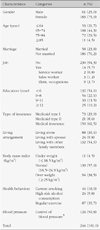Abstract
Purpose
This study was to investigate the effect of home visiting care service and to evaluate the effect from the cost-benefit perspective.
Methods
Target participants were enrolled in 2007~2008 for home visiting care and provided with a home visiting nursing service for more than 18 months in J Ward of S City. Of 391 participants, 244 who satisfied the inclusion criteria were used in the final analysis. Cost-benefit analysis was done using the net benefit and benefit/cost ratio.
Results
After providing the home care nursing service, the blood pressure control rate increased from 50.8% to 75.4%. Of the subjects, 39.8% maintained their blood pressure level within the target range. As a whole, the net benefit of home visiting care per person ranged from 434,964.86 to 447,112.43 won and the benefit/cost ratio ranged from 2.82 to 2.84.
Conclusion
Home visiting care for vulnerable populations with hypertension was effective in both maintaining blood pressure and reducing blood pressure to the target range. Therefore these results are especially useful for establishing the value of home visiting services for policy makers as well as for prioritizing vulnerable populations.
Figures and Tables
References
1. Ahn YO, Kim DH, Bae JM, Lee MS, Shin MH, Lee SI. A study on effective implementation of health examination. Seoul: National Health Insurance Corporation;1995.
2. Alcocer L, Cueto L. Review: Hypertension, a health economics perspective. Ther Adv Cardiovasc Dis. 2008; 2:147–155. doi: 10.1177/1753944708090572.

3. Bae SI, Kim JS, Park IS. The cost-benefit analysis for high blood pressure in health examination. Korean J Health Econ Policy. 2005; 11:39–61.
4. Bae S, Kim J, Min K, Kwon S, Han D. Patient compliance and associated factors in the community-based hypertension control program. Korean J Prev Med. 1999; 32:215–227.
5. Cantor JC, Morisky DE, Green LW, Levine DM, Salkever DS. Cost-effectiveness of educational interventions to improve patient outcomes in blood pressure control. Prev Med. 1985; 14:782–800. doi: 10.1016/0091-7435(85)90071-4.

6. Collins R, Peto R, MacMahon S, Hebert P, Fiebach NH, Eberlein KA, et al. Blood pressure, stroke, and coronary heart disease. part 2, short-term reductions in blood pressure: overview of randomised drug trials in their epidemiological context. Lancet. 1990; 335:827–838. doi: 10.1016/0140-6736(90)90944-Z.
7. Earp JA, Ory MG, Strogatz DS. The effects of family involvement and practitioner home visits on the control of hypertension. Am J Public Health. 1982; 72:1146–1154.

8. Grover SA, Coupal L, Kaouache M, Lowensteyn I. Preventing cardiovascular disease among canadians: What are the potential benefits of treating hypertension or dyslipidemia? Can J Cardiol. 2007; 23:467–473. doi: 10.1016/S0828-282X(07)70786-9.

9. Jung YH, Ko SJ. Estimating socioeconomic costs of five major disease. Public Finance Rev. 2004; 18:77–104.
10. Kang YS, Lee SJ, Yang BM, Hur J. Cost-benefit analysis of nursing intervention program for the aged. J Korea Gerontol Soc. 1988; 8:120–144.
11. Kaplan GA, Keil JE. Socioeconomic factors and cardiovascular disease: A review of the literature. Circulation. 1993; 88:1973–1998.

12. Kim JH, Lee HY, Jung HJ. 2007 National health insurance statistical yearbook. Seoul: Health Insurance Review & Assessment Service, National Health Insurance Corporation;2008.
13. Ko IS, Kim GS, Lim MH, Lee KJ, Lee TW, Park HS, et al. Effects of health education on the knowledge and self-care of hypertension for visiting nursing clients. J Korean Acad Public Health Nurs. 2007; 21:134–145.
14. Korea Center for Disease Control and Prevention. 2007 National health statistics: the first year (2007) of the 4th the national health and nutrition examination survey. 2008. 12. Retrieved October 5, 2009. from http://knhanes.cdc.go.kr.
15. Lee JY, Kim HL, Kim YH. Difference of self-care behavior implementation in clients with hypertension by visiting nursing service. Chungnam J Nurs Acad. 2006; 9:53–62.
16. Lee TW, Ko IS. Cost-benefit analysis on community health practitioner. J Korean Acad Nurs. 2002; 32:435–446.

17. Liljas B. How to calculate indirect costs in economic evaluations. Pharmacoeconomics. 1998; 13(1 Pt 1):1–7.

18. Management Center For Health Promotion. Estimation of optimal workload for the visiting nurse of customizing health care through the job analysis. Seoul: Ajou University, Management Center For Health Promotion;2009-a. 03.
19. Management Center For Health Promotion. 2007 Customized home visiting care project yearbook. Seoul: Management Center For Health Promotion, Ministry of Health, Welfare and Family Affairs;2009-b. 12.
20. Ministry of Health and Welfare. Result report of customized home visiting care project in 2007. Seoul: Ministry of Health and Welfare;2007. 11.
21. Ministry of Labor. Survey report on wage structure. Seoul: Ministry of Labor;2008. 05.
22. Ministry of Public Administration and Security. Civil service pay. guidance. 2008. 06. Retrieved December 15, 2009. from www.mopas.go.kr.
23. Park JG, Choi MJ. Automobile insurance. Incheon: SunHak Press;2004.
24. Park KO. Nurse! Why do they leave small and medium hospitals? Korean Nurses Association Policy Forum, Seoul, Korea. 2008. 11. Retrieved November 20, 2009. from http://www.khna.or.kr/resource/frame_data.php.
25. Shin HS, Lee TJ, Yang BM. The economic analysis on visiting nurse program. J Ins Health Environ Sci. 1993; 3:9–17.
26. Statistics Korea. Economic activity participation rate and consumer price index. 2009. Retrieved October 24, 2009. from http://www.kostat.go.kr/.
27. The Korean Society of Hypertension. 2004 Korean hypertension treatment guidelines. Seoul: Committee on Guidelines of Hypertension Treatment, The Korean Society of Hypertension;2004. 12.
28. World Health Organization. The world health report 2002-reducing risks, promoting healthy life. Geneva: World Health Organization;2002. 10.
29. Yang BM, Kim JH, Lee SY. The economic analysis of industrial health promotion program: A cost-benefit analysis of preventing occupational disease program in Korea. Seoul: Ministry of Labor;1992.
30. Yonsei University Health Promotion Project Support Group. Cost-effectiveness analysis of national prevention programs for cardiovascular disease. Seoul: Management Center for Health Promotion, The Korea Institute for Health and Social Affairs;2007.




 PDF
PDF ePub
ePub Citation
Citation Print
Print







 XML Download
XML Download